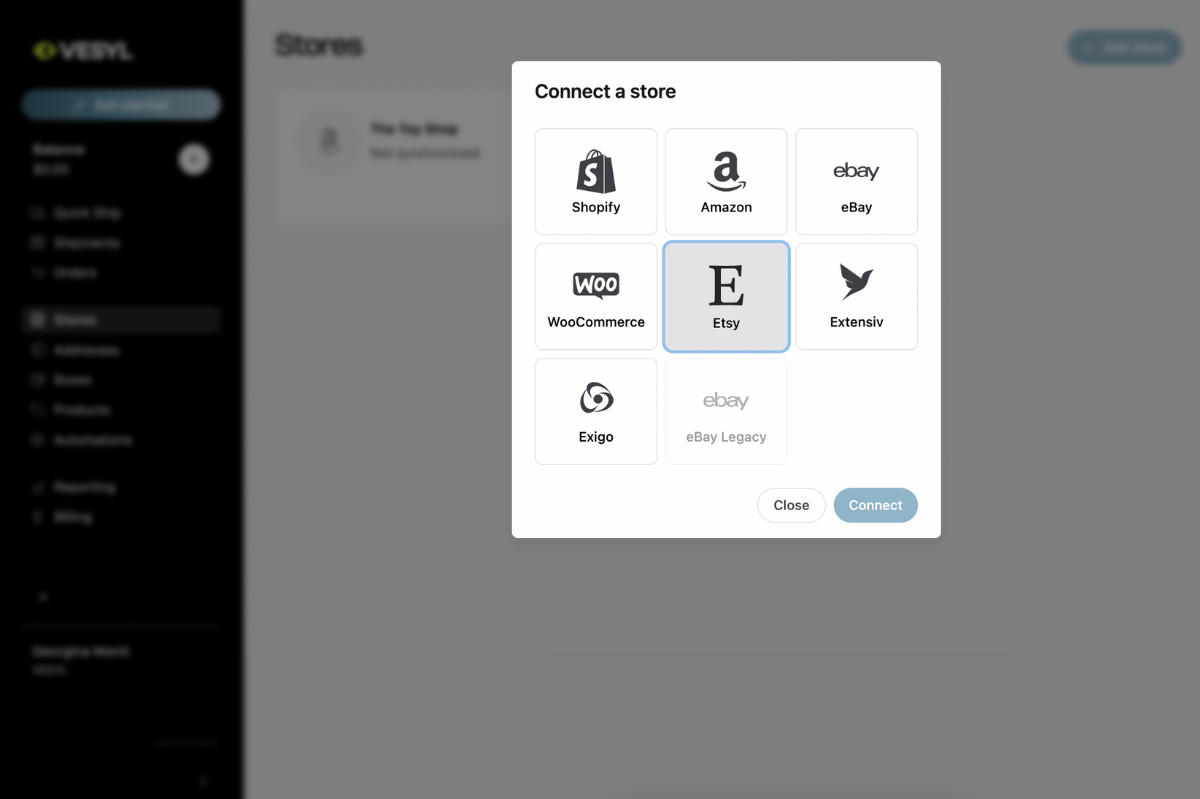As ecommerce businesses grow, so do the challenges of shipping ecommerce orders efficiently. Manual tasks—like printing shipping labels, managing disconnected shipping carriers, or switching between siloed ecommerce platforms—slow down the shipping process, increase shipping costs, and make the entire fulfillment process harder to scale.
That’s why ecommerce shipping software integrations with platforms like Shopify, BigCommerce, and WooCommerce are essential. The right ecommerce shipping solutions streamline the order fulfillment process by automating shipping labels, syncing with multiple shipping carriers, and offering flexible ecommerce shipping options like flat rate shipping, expedited shipping, and international shipping.
But integration means more than just installing an app. It’s about how well your ecommerce shipping strategy adapts in real time—connecting your shipping software, ecommerce platform, and shipping service to reduce shipping expenses, improve shipping speed, and meet customer expectations with fast delivery and accurate tracking.
Why Integrations Matters for Ecommerce Businesses
For direct-to-consumer (DTC) brands, strong ecommerce shipping software integrations are essential—not just a technical upgrade, but the backbone of a successful ecommerce shipping strategy. Today’s customers expect fast delivery, accurate shipping rates, real-time tracking, and shipping options like free shipping or overnight shipping.
To meet these expectations, DTC ecommerce businesses must connect their shipping software with ecommerce platforms like Shopify or WooCommerce. This integration automates the shipping process—from calculating shipping costs at checkout to generating shipping labels and updating customers on delivery status.
As ecommerce continues to grow, seamless shipping services and a frictionless fulfillment process are what set top-performing brands apart. Whether you're shipping products locally or handling international shipments, the best shipping solution helps scale operations, reduce shipping expenses, and boost customer satisfaction.
Flat Rate Shipping to Free Shipping: Understanding Shipping Models
Choosing the right ecommerce shipping model is essential for balancing shipping costs, customer satisfaction, and operational efficiency. DTC brands have several options to consider, each with its own impact on the bottom line and the customer experience.
Flat rate shipping offers a predictable shipping cost for customers, regardless of package weight or destination. This model simplifies the checkout process and can encourage higher order values, but it requires careful calculation to avoid eroding margins on heavier or distant shipments.
Free shipping is a powerful incentive for shoppers and can boost conversion rates, but the business must absorb the shipping cost. Many ecommerce businesses offset this expense by setting minimum order thresholds or adjusting product prices. Offering free shipping can be a strategic move, especially when competitors are doing the same, but it’s important to monitor its impact on profitability.
Expedited shipping options, such as overnight shipping or two-day shipping, cater to customers who value speed and are willing to pay a premium for fast delivery. Integrating with reliable shipping carriers like DHL Express allows brands to offer these services efficiently, ensuring that expedited orders are fulfilled without delays.
International shipping opens up new markets but introduces additional complexities, including customs compliance and higher shipping expenses. Using advanced shipping software helps automate documentation and select the best shipping solution for each destination, keeping international shipping costs manageable.
Ultimately, the right mix of shipping models depends on your products, target customers, and business goals. Leveraging shipping software and partnering with trusted shipping carriers enables ecommerce businesses to optimize their shipping strategy, reduce shipping expenses, and deliver a positive experience with every order.
Integration Isn’t Just About Syncing Orders
Too many tools promise a plug-and-play experience, but few hold up once you introduce real operational complexity: multiple warehouses, including fulfillment warehouses that are essential for streamlining the fulfillment process, region-based SLAs, dynamic carrier contracts, bundled kits, or international DDP shipments.
A mature integration needs to handle:
- Real-time order flow with no delays or batch jobs
- Bi-directional updates between your ecommerce platform and WMS/3PL, supporting the order fulfillment process and ensuring the entire process from order receipt to delivery is seamless
- Carrier logic that adjusts on the fly based on inventory, packaging, or cutoff times
- Flexible mappings between your storefront’s order data and what your warehouse or carrier systems need
When these pieces are truly connected, brands stop firefighting fulfillment and start using it as a strategic lever. A well-integrated system streamlines the entire fulfillment process, improving efficiency and customer satisfaction.
The Real Value: Automating Without Losing Control
DTC leaders often hesitate to automate shipping because they don’t want to hand off control—or create brittle systems that break under edge cases. That’s a valid concern. But the right integration doesn’t remove decision-making—it streamlines it. The right automation and integration lets your team move faster without creating more exceptions to manage later. Automation also helps keep customers informed throughout the delivery process by enabling real-time tracking and notifications, which enhances the overall customer experience.
What this shipping process looks like in practice:
- Carrier selection rules that adapt to shipping zones, weights, or delivery promise windows, and help you choose the best shipping method and shipping service based on shipping speed and available options from different carriers
- Fallback logic when preferred methods aren’t available (e.g., USPS outage or FedEx delay), with the ability to automatically switch to a different shipping carrier if needed
- Pre-mapped packaging rules so warehouse teams aren’t making guesses
- Real-time reporting at the order, batch, or lane level to spot cost anomalies quickly
- Shipping insurance is essential for protecting ecommerce shipments against loss, theft, or damage during transit
When done right, integration lets your team move faster without creating more exceptions to manage later.
Platform-Specific Considerations for Ecommerce Shipping Software
Each ecommerce platform has its own quirks and limitations that impact how integrations behave. These differences can significantly affect your online store, influencing how orders are managed and the overall process of shipping products to customers.
Shopify
- Native integrations are robust, but not always flexible—watch for rate limits and webhook delays.
- Third-party fulfillment locations can cause sync issues if not mapped properly.
- Shopify Scripts and checkout extensibility can introduce complexity in how shipping methods are displayed.
BigCommerce
- Offers more backend customization, but requires hands-on configuration for some workflows.
- Can support advanced use cases like B2B pricing tiers or multi-location routing—but not without technical lift.
WooCommerce / Custom Builds
- High flexibility, but integration depends heavily on how your stack is architected.
- Custom code and plugins can break data flows if not tested with every update.
Bottom line: the integration method matters as much as the software itself. Make sure your vendor understands the operational nuances of your platform, not just the marketing pitch.
Seamless Shipping Software Integrations with VESYL
VESYL simplifies ecommerce integrations by connecting your tech stack with leading marketplaces, ecommerce platforms, and fulfillment centers offering:
- Real-time syncing with platforms like Amazon, Walmart, eBay, Shopify, and BigCommerce
- Custom integration logic for different shipping carriers and warehouse systems
- Scalable support for multi-node and multi-region fulfillment
- Unified tracking, label generation, and analytics dashboard
This makes VESYL the best shipping solution for fast-growing ecommerce businesses that want reliability, flexibility, and instant savings from smarter shipping services.

What to Vet Before You Commit: Shipping Costs and More
Not all shipping software is built to handle scale. Ask your vendor:
- Can it handle multiple storefronts and WMS systems simultaneously?
- Is the integration real-time or batch-based?
- Does it support custom workflows (e.g., subscription box fulfillment, bundling, or pre-orders)?
- How is failure handled—does it retry, flag, or require manual override?
- Can you export shipping cost data and carrier performance metrics cleanly?
- How does the software manage packaging costs, packaging materials, custom packaging, and branded packaging to optimize both cost and customer experience?
- Does the software support integration with different carriers, including Royal Mail, and can you use your own account to access negotiated rates?
- How does the software manage shipping products, ship orders, and ship products efficiently to ensure timely and accurate deliveries?
- Does the software support various ecommerce shipments and ecommerce shipping options to help you optimize fulfillment and customer satisfaction?
The best tools don’t just “connect.” They let you build process logic around your shipping, not inside it.
Final Thoughts: The Value of Smart Ecommerce Shipping Solutions
Great ecommerce shipping software integrations aren’t about automation alone—they're about giving your team the tools to build a resilient, scalable shipping infrastructure. For DTC ecommerce businesses managing complex logistics across channels and regions, the right integration:
- Streamlines the order fulfillment process
- Reduces manual effort and shipping costs
- Improves shipping speed and customer satisfaction
Invest in shipping software that helps you scale your shipping strategy while keeping full control of how you ship products, manage ecommerce shipments, and meet ever-rising customer expectations.
Related Topics
Learn how VESYL can save you money on shipping
Not sure which plan suits you best? Have questions about our software? Contact our sales team for expert guidance.
.png)
.png)

.png)
.png)
.png)

.png)